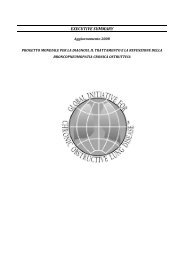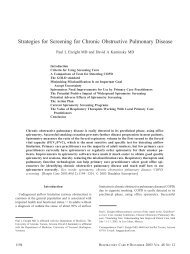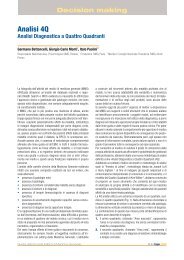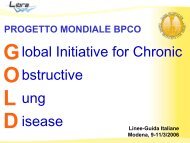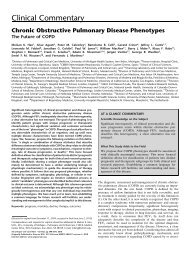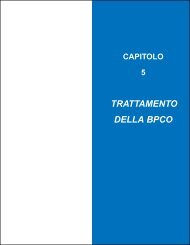Application of Number Needed to Treat (NNT) - GOLD
Application of Number Needed to Treat (NNT) - GOLD
Application of Number Needed to Treat (NNT) - GOLD
You also want an ePaper? Increase the reach of your titles
YUMPU automatically turns print PDFs into web optimized ePapers that Google loves.
80 Cazzola<br />
THIS MANUSCRIPT IS PROVIDED IN CONFIDENCE TO DETERMINE REPRINT INTEREST ONLY AND SHOULD NOT BE DISTRIBUTED<br />
EITHER INTERNALLY OR EXTERNALLY VIA PRINT OR ELECTRONIC MEDIA FOR OTHER THAN THE STATED PURPOSE.<br />
1. Interpreting Clinical Trial Results intervention is identical in both high- and low-risk groups (25%),<br />
the absolute risk reduction is considerably higher in the high-risk<br />
Absolute and relative risk reductions are used extensively <strong>to</strong> (10%) than in the low-risk (2.5%) group.<br />
summarize the effects <strong>of</strong> treatment in clinical trials (table I). In a While relative risk reduction can provide a basis for balancing<br />
parallel-group study, for instance, the relative risk, or the risk <strong>of</strong> an benefits and drawbacks <strong>of</strong> therapy, it should be accompanied by an<br />
event in the treatment group relative <strong>to</strong> that in the control group, is estimate <strong>of</strong> baseline or untreated risk in individual patients, and<br />
defined as the ratio <strong>of</strong> the risks in the two treatment groups (i.e. the may be subject <strong>to</strong> differences in interpretation. Absolute risk, as<br />
probability <strong>of</strong> an event in the active treatment group divided by the<br />
probability in the control group). [6] Although this concept is<br />
straightforward and easily unders<strong>to</strong>od, it may not give a clinically<br />
meaningful illustration <strong>of</strong> the difference between treatments, as the<br />
value attached <strong>to</strong> any change will be the same regardless <strong>of</strong> the<br />
baseline severity <strong>of</strong> disease (see McQuay and Moore [7] and Barratt<br />
et al. [8] for further details).<br />
A comparison can also be expressed in terms <strong>of</strong> the relative risk<br />
reduction, which is the difference in event rates between the two<br />
treatment groups (usually constant across groups with different<br />
risks). This measure is obtained by subtracting the relative risk<br />
from 1, and is therefore the ratio between the decrease in risk in the<br />
group <strong>of</strong> interest and the risk in the control or compara<strong>to</strong>r group. It<br />
is worth noting at this point that although relative risk and relative<br />
risk reduction give a good quantitative illustration <strong>of</strong> clinical effect<br />
in proportional terms, they do not tell practitioners anything about<br />
effect sizes on an absolute scale. [7]<br />
Although absolute risk conveys little information on proportional<br />
effects, it is a much better indica<strong>to</strong>r <strong>of</strong> whether an interven-<br />
tion has effects that are likely <strong>to</strong> be clinically meaningful. Its chief<br />
disadvantage is that it is a dimensionless and abstract number that<br />
lacks a direct connection with the particular clinical situation. [7]<br />
Absolute risk reduction, or risk difference, is an important alterna-<br />
tive expression <strong>of</strong> comparative results, and is simply the difference<br />
in event rates between groups. [8] These concepts are illustrated in<br />
figure 1, where an example is used <strong>of</strong> a hypothetical trial in which<br />
interventions are being compared in two groups <strong>of</strong> patients (high-<br />
and low-risk groups). While the relative risk reduction for the<br />
Table I. Definitions <strong>of</strong> measures used <strong>to</strong> report outcomes in clinical trials [8]<br />
Measure<br />
Absolute risk<br />
reduction<br />
Relative risk<br />
reduction<br />
<strong>Number</strong> needed <strong>to</strong><br />
treat<br />
<strong>Number</strong> needed <strong>to</strong><br />
harm<br />
Definition<br />
The arithmetic difference between two event<br />
rates<br />
The difference in event rates between two<br />
groups expressed as a proportion <strong>of</strong> the event<br />
rate in the untreated group<br />
The inverse <strong>of</strong> absolute risk reduction, or the<br />
number <strong>of</strong> patients who would have <strong>to</strong> receive<br />
treatment for one <strong>of</strong> them <strong>to</strong> benefit<br />
The inverse <strong>of</strong> absolute risk reduction, or the<br />
number <strong>of</strong> patients who would have <strong>to</strong> receive<br />
treatment for one <strong>of</strong> them <strong>to</strong> experience an<br />
adverse outcome<br />
already stated, lacks a direct connection with the clinical setting.<br />
Neither <strong>of</strong> these measures aid clinical decision making. <strong>NNT</strong><br />
provides a means <strong>of</strong> achieving this end.<br />
2. <strong>Number</strong> <strong>Needed</strong> <strong>to</strong> <strong>Treat</strong> (<strong>NNT</strong>)<br />
<strong>NNT</strong> is the reciprocal <strong>of</strong> the absolute risk reduction (expressed<br />
as a proportion) associated with the treatment or intervention<br />
under examination. [9] Thus, <strong>NNT</strong> is the number <strong>of</strong> patients who<br />
would have <strong>to</strong> receive treatment in order for one individual <strong>to</strong><br />
benefit from treatment or <strong>to</strong> avoid an adverse outcome over a<br />
given period <strong>of</strong> time.<br />
As an example, where <strong>NNT</strong> = 10:<br />
• treatment has <strong>to</strong> be given <strong>to</strong> 10 patients for improvement/<br />
prevention <strong>of</strong> adverse outcome in one; or<br />
• each patient who receives treatment has a 1 in 10 chance <strong>of</strong><br />
benefiting from treatment.<br />
Table II shows how <strong>NNT</strong> is calculated from absolute risk<br />
reduction (as illustrated for the example in figure 1) in high- and<br />
low-risk patients. Only 10 patients in the high-risk group need <strong>to</strong><br />
receive the intervention for a benefit <strong>to</strong> be seen in one <strong>of</strong> them,<br />
whereas this number rises <strong>to</strong> 40 in the low-risk group. This<br />
distinction is not evident from relative risk (figure 1); both groups<br />
have reductions in risk relative <strong>to</strong> control <strong>of</strong> 25%. <strong>NNT</strong> therefore<br />
captures the effect <strong>of</strong> the baseline condition.<br />
<strong>NNT</strong> values approaching 1 indicate that the outcome under<br />
investigation occurs in almost all treated patients and, conversely,<br />
in few patients in the compara<strong>to</strong>r group. In practice, low <strong>NNT</strong><br />
values <strong>of</strong> this magnitude rarely occur, with the possible exception<br />
<strong>of</strong> interventions such as the use <strong>of</strong> antibacterials versus placebo. [7]<br />
While <strong>NNT</strong> values <strong>of</strong> 2–3 indicate that a treatment is quite<br />
effective, some prophylactic interventions with <strong>NNT</strong>s as high as<br />
20–40 may still be regarded as clinically effective. [7]<br />
In addition <strong>to</strong> <strong>NNT</strong>, the number needed <strong>to</strong> harm (NNH) can be<br />
calculated. This is the number <strong>of</strong> patients who would have <strong>to</strong><br />
undergo treatment for one <strong>of</strong> them <strong>to</strong> experience an adverse event.<br />
NNH is determined as 100 divided by the absolute risk increase<br />
expressed as a percentage (or the reciprocal <strong>of</strong> the risk expressed<br />
as a proportion). Several variations <strong>of</strong> <strong>NNT</strong> have also been developed.<br />
These include <strong>NNT</strong> at any time after the start <strong>of</strong> treatment<br />
(see Altman and Andersen [10] ) and the number needed <strong>to</strong> screen<br />
(see Rembold [11] ).<br />
© 2006 Adis Data Information BV. All rights reserved. <strong>Treat</strong> Respir Med 2006; 5 (2)




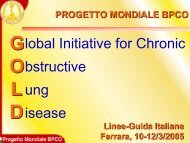
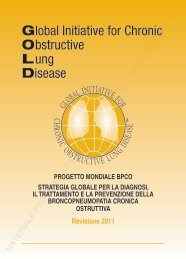
![Di Bari [NO].pdf - GOLD](https://img.yumpu.com/21544924/1/190x143/di-bari-nopdf-gold.jpg?quality=85)

